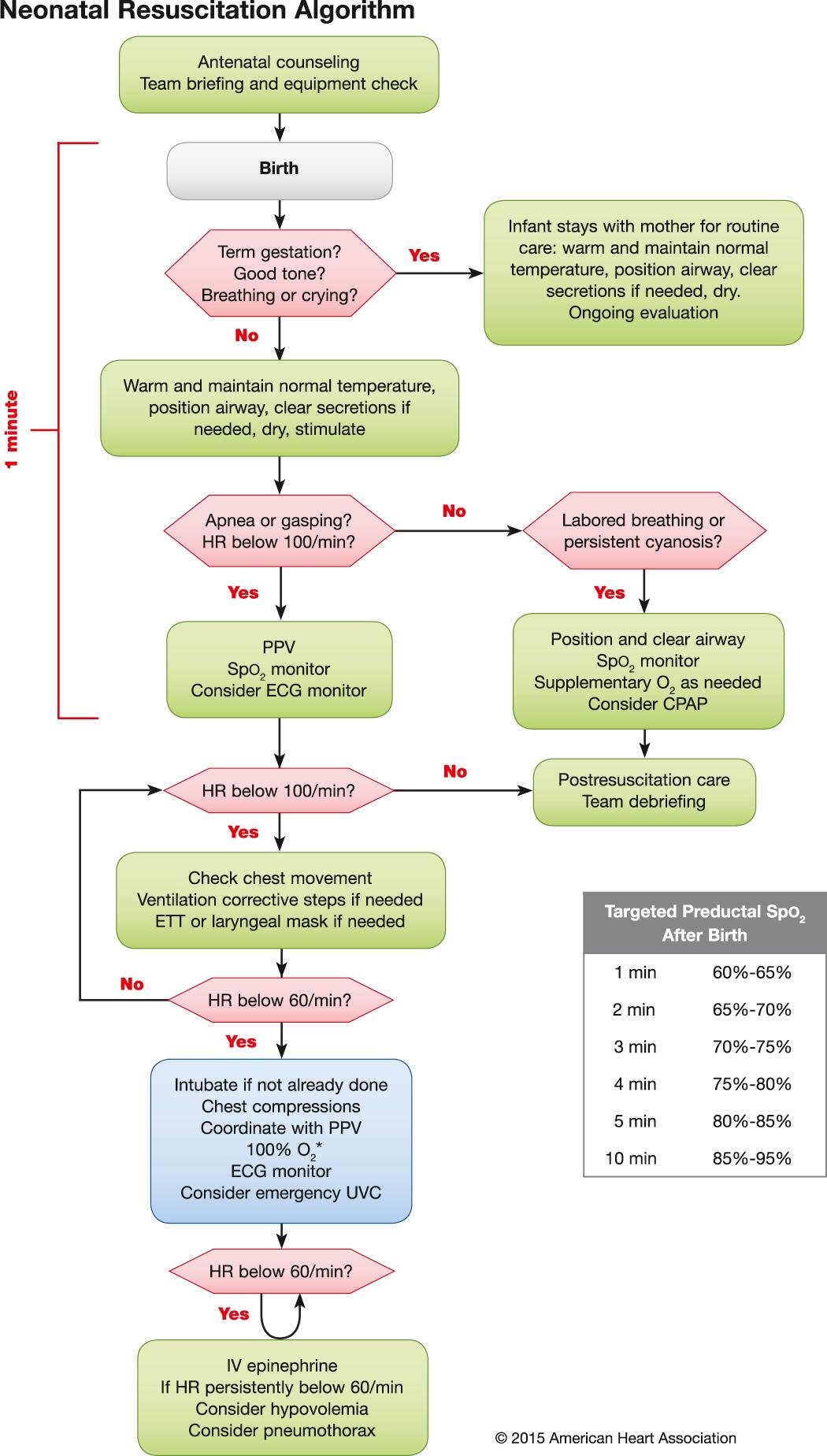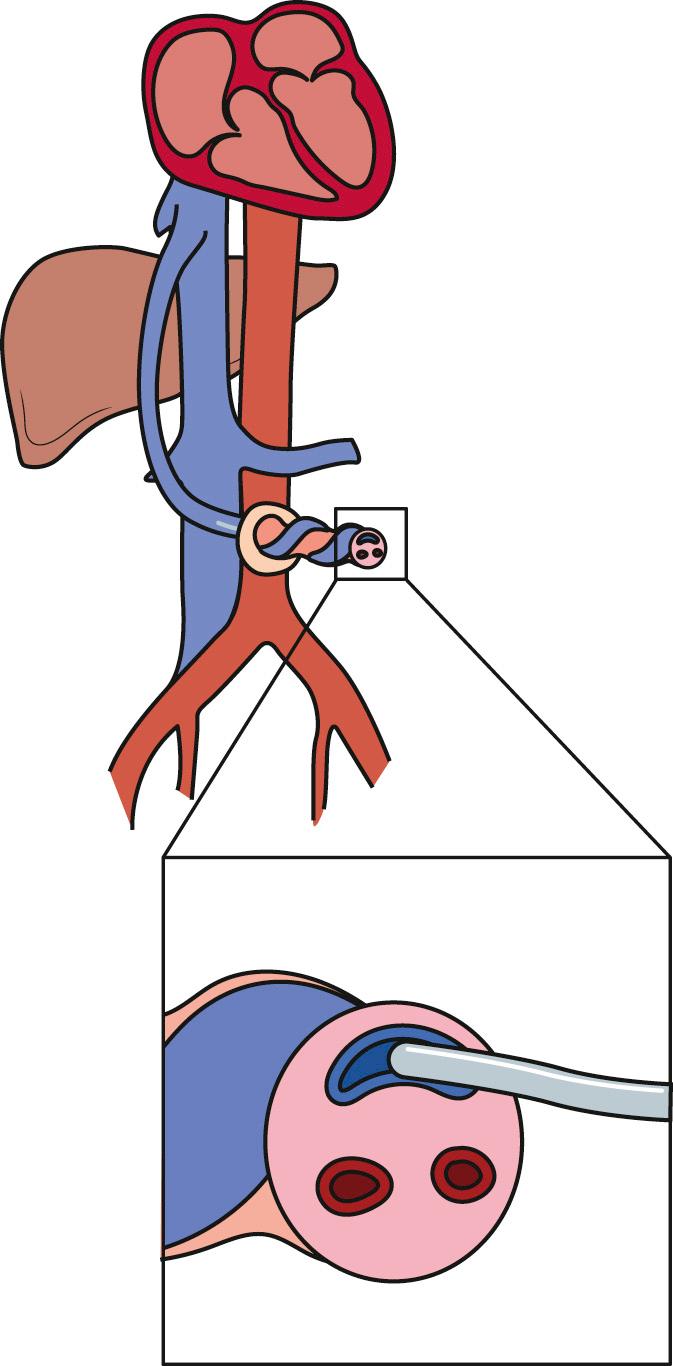Physical Address
304 North Cardinal St.
Dorchester Center, MA 02124
Most infants complete the transition to extrauterine life without difficulty; however, a small proportion require resuscitation after birth ( Fig. 121.1 ). For a newborn infant, the need for resuscitation is often caused by a problem with respiration leading to inadequate ventilation. This is in contrast to an adult cardiac arrest, which is usually caused by inadequate circulation. The goals of neonatal resuscitation are to reestablish adequate spontaneous respirations, obtain adequate cardiac output, and prevent the morbidity and mortality associated with hypoxic-ischemic tissue (brain, heart, kidney) injury. High-risk situations should be anticipated from pregnancy history and labor. Improved perinatal care and prenatal diagnosis of fetal anomalies allow for appropriate maternal transports for high-risk deliveries. Infants who are born limp, cyanotic, apneic, or pulseless require immediate resuscitation before assignment of the 1 min Apgar score. Rapid and appropriate resuscitative efforts improve the likelihood of preventing brain damage and achieving a successful outcome.
See also Chapter 81 .
Guidelines for the Neonatal Resuscitation Program (NRP) are based on recommendations from the International Liaison Committee on Resuscitation Consensus on Treatment Recommendations. These recommendations propose an integrated assessment/response approach for the initial evaluation of an infant, consisting of simultaneous assessment of infant general appearance and risk factors. The fundamental principles include evaluation of the airway and establishing effective respirations and adequate circulation. The guidelines also highlight the assessment and response to the neonatal heart rate.
Before the birth of a baby, sufficient preparation for the birth should occur. At least 1 individual capable of neonatal resuscitation should be present at the delivery, and if advanced resuscitation is anticipated, more individuals should be available to help. Necessary equipment should be available, which routinely includes: a warmer bed, blankets, infant hat, stethoscope, bulb suction, suction catheter with wall suction, bag-mask device, oxygen source with blender, pulse oximeter, laryngoscope with blade, and endotracheal tubes (ETTs). Based on the specific details of the pregnancy, further equipment that may be needed should be anticipated and readily available. The equipment should be checked to make sure it is functioning appropriately. Team members should introduce themselves, define a team leader, assign roles for the resuscitation, and discuss what actions they will take during the resuscitation. For complex resuscitations, there may be 1 individual whose sole job is to keep track of time and record what interventions are taken, both to ensure the correct steps are performed in a timely manner and to review during debriefing later.
Immediately after birth, all term infants should be dried, warmed, and stimulated. If the infant does not need resuscitation, these steps can occur on the mother's abdomen while delayed cord clamping is taking place. Simultaneously, the infant's tone, respiratory effort, and heart rate should be assessed ( Fig. 121.2 ).

Failure to initiate or sustain respiratory effort is fairly common at birth, with 5–10% of births requiring some intervention. Infants with primary apnea respond to stimulation by establishing normal breathing. Infants with secondary apnea require some ventilatory assistance in order to establish spontaneous respiratory effort. Secondary apnea usually originates in the central nervous system (CNS) as a result of asphyxia or peripherally because of neuromuscular disorders. The lungs in infants affected by conditions such as pulmonary hypoplasia and prematurity may be noncompliant, and initial efforts to begin respirations may be inadequate to initiate sufficient ventilation.
The steps in neonatal resuscitation follow the ABCs: A, anticipate and establish a patent airway by positioning the baby with the head slightly extended, sniffing position, and suctioning if secretions are blocking the airway; B, initiate breathing first by using tactile stimulation, followed by positive pressure ventilation (PPV) with a bag-mask device and ETT insertion should the baby remain apneic or PPV is not achieving effective ventilation; and C, maintain the circulation with chest compressions and medications, if needed. Fig. 121.2 outlines the steps to follow for immediate neonatal evaluation and resuscitation.
In term infants after stimulation, if no respirations are noted, or if the heart rate is <100 beats/min, PPV should be given through a tightly fitted and appropriately sized bag-mask device. PPV should be initiated at pressures of approximately 20 cm H 2 O at a rate of 40-60 breaths/min initially with 21% fraction of inspired oxygen (F io 2 ) for full-term infants.
At the same time PPV is initiated, a pulse oximeter should be placed on the right hand (preductal) and cardiac leads placed on the chest. In the past the recommended inspired gas for neonatal resuscitation had been 100% oxygen. However, resuscitation with room air in term infants is equally effective and may reduce the risk of hyperoxia, which is associated with decreased cerebral blood flow and generation of oxygen free radicals. Room air is the preferred initial gas for neonatal resuscitation in term infants. O 2 concentration administered should then be titrated as needed to obtain expected O 2 saturations in a term infant after birth, as defined by normal reference range by minute of life (see Fig. 121.2 ).
Successful and effective ventilation is signified by adequate chest rise, symmetric breath sounds, improved pink color, heart rate >100 beats/min, increasing O 2 saturation, spontaneous respirations, and improved tone. If after 30 sec of providing PPV there are no signs of effective ventilation, corrective steps should be performed to improve ventilation. The 6 ventilation corrective steps can be remembered with the mnemonic MRSOPA : m ask readjustment, r eposition the head, s uction mouth and nose, o pen the mouth, p ressure increase, and a lternative airway).
In infants with severe respiratory depression who do not respond to PPV by bag-mask, after corrective steps have been taken, endotracheal intubation should be performed. For infants with an otherwise normal airway weighing <1,000 g, ETT size is usually 2.5 mm; for infants 1,000-2,000 g, 3 mm; and for infants >2,000 g, 3.5 mm. A general rule for depth of insertion from upper lip in centimeters is 6 plus infant's weight in kilograms. Poor response to ventilation may be a result of a loosely fitted mask, poor positioning of the ETT, esophageal intubation, airway obstruction, insufficient pressure, pleural effusions, pneumothorax, excessive air in the stomach leading to abdominal competition, asystole, hypovolemia, diaphragmatic hernia, or prolonged intrauterine asphyxia. Various devices to detect exhaled CO 2 and to confirm accurate ETT placement are available. A laryngeal mask airway may also be an effective tool to establish an airway, especially if PPV is ineffective and intubation attempts are unsuccessful.
The underlying cause for the vast majority of infants having a low heart rate is not a primary cardiac cause, but instead the result of ineffective ventilation . Therefore, if the heart rate remains <60 beats/min after 60 sec of PPV with corrective MRSOPA steps, the infant should be intubated (if not already done) to achieve effective ventilation. Once the infant is intubated, if the heart rate remains <60 beats/min, chest compressions should be initiated with continued ventilation, and F io 2 increased to 100%. Chest compressions should be initiated over the lower third of the sternum at a rate of 90/min. The ratio of compressions to ventilation is 3 : 1 (90 compressions:30 breaths). A provider, separate from the person providing ventilation, is needed to administer chest compressions. Two different techniques exist for performing chest compressions: the thumb technique and the 2-finger technique. For the thumb technique the tips of both thumbs are used to depress the sternum, with the fingers on each side encircling the chest; this is the preferred method to administer chest compressions, because it has been shown to achieve a higher blood pressure, increase coronary perfusion, and result in less fatigue. The 2-finger technique involves depressing the sternum with the tips of the middle finger and index finger while supporting the back with the palm of the other hand. In infants, regardless of whether an alternative airway has been secured, chest compressions are always coordinated with PPV. Chest compressions should continue uninterrupted for 45-60 sec before reassessing heart rate to determine next steps.
Medications are rarely required, but epinephrine should be administered when the heart rate is <60 beats/min after 60 sec of combined ventilation and chest compressions or during asystole. Persistent bradycardia in neonates is usually attributable to hypoxia resulting from respiratory arrest and often responds rapidly to effective ventilation alone. Persistent bradycardia despite what appears to be adequate resuscitation suggests inadequate ventilation or more severe cardiac compromise.
The umbilical vein can generally be readily cannulated and is the preferred method for administration of medications and volume expanders during neonatal resuscitation ( Fig. 121.3 ). The ETT may be used for the administration of epinephrine if intravenous access is not yet available. Epinephrine (1 : 10,000 solution at 0.1-0.3 mL/kg intravenously or 0.5-1 mL/kg intratracheally ) is given for asystole or for continued heart rate <60 beats/min after 60 sec of combined resuscitation. The dose may be repeated every 3-5 min. If adequate resuscitation continues for 10 min without a detectable heart rate, it is reasonable to stop resuscitative efforts.

Resuscitation of the preterm infant should follow the same steps as a term infant, with some special considerations. Whereas resuscitation of term infants should start with room air, resuscitation of most preterm infants can be initiated with slightly higher F io 2 , 21–30%. Pulse oximetry of the preductal (right) hand should be used to titrate O 2 concentrations for targeted saturations per the NRP algorithm (see Fig. 121.2 ).
Special attention should be paid to keeping the preterm infant warm in the delivery room. Quality improvement projects have initiated bundles to improve admission temperatures of preterm infants to the neonatal intensive care unit (NICU) and have included such interventions as higher ambient temperatures in the delivery room, immediate placement of preterm infants into a plastic bag or under plastic wrap rather than drying, and exothermic mattress for resuscitation and transport of the preterm infant.
Delayed cord clamping for 1-3 min can be performed in both preterm and term infants but is especially recommended for preterm infants. Benefits to term infants include higher hemoglobin levels at birth with improved iron stores in the 1st several mo of life. Additional benefits for preterm infants include improved hemodynamic stability, decreased need for inotropic support, decreased need for transfusions, and decreased risk of necrotizing enterocolitis and intraventricular hemorrhage. The American College of Obstetricians and Gynecologists (ACOG) recommends at least 30-60 sec of delayed cord clamping after birth for vigorous term and preterm infants. It is unclear, however, whether delayed cord clamping should be continued when an infant requires resuscitation. Studies are investigating whether the onset of respirations before delayed cord clamping is beneficial for both hemodynamic stability and decreased neonatal mortality.
Meconium staining of the amniotic fluid may be an indication of fetal stress. Previously, the presence of meconium-stained amniotic fluid in a nonvigorous infant required tracheal intubation to attempt to aspirate meconium below the cords; NRP recommendations (7th edition) no longer support this practice. If an infant is born through meconium-stained amniotic fluid, it does not matter whether they are vigorous or nonvigorous; the infant should receive the same initial steps of basic resuscitation and should be assessed as any other infant. Tracheal intubation may delay the initiation of effective PPV, which will help the baby to breathe and achieve effective gas exchange.
Become a Clinical Tree membership for Full access and enjoy Unlimited articles
If you are a member. Log in here